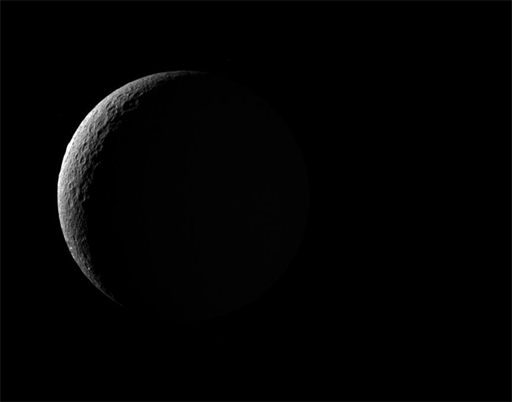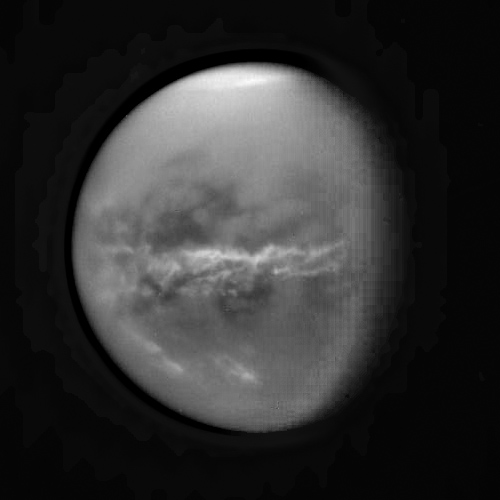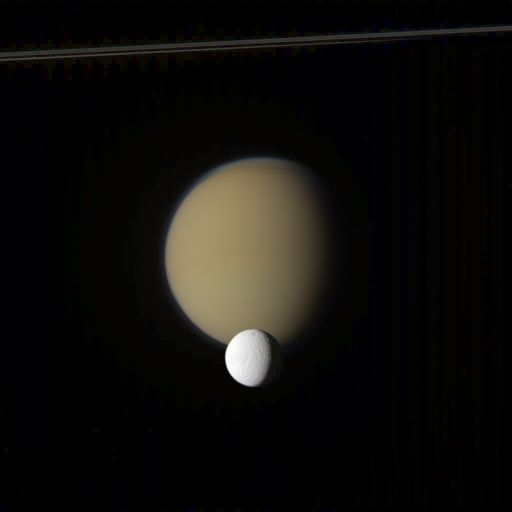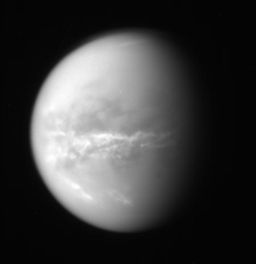Emily Lakdawalla • Oct 20, 2010
A Rhea flyby and a cloudy Titan with Tethys in color
Over the last few days, the Cassini Saturn orbiter's raw images website has been bursting with awesome pictures. In the past week, Cassini passed reasonably close to, and imaged, Titan, Mimas, Pallene, Dione, and Rhea. (Pallene is a tiny moon located between the orbits of Mimas and Enceladus). Here, just for fun, is an animation of five wide-angle photos of Rhea.

NASA / JPL / SSI / animation by Emily Lakdawalla
Cassini flies past Rhea
Cassini captured these five images of Rhea during a relatively close encounter (within 40,000 kilometers at closest approach) on October 17, 2010. The images were captured with its wide-angle camera, which has a field of view ten times broader than its companion narrow-angle camera. The biggest visible impact basin is Tirawa.To make the animation, I selected five of the wide-angle camera images (1, 2, 3, 4, 5), adjusted their levels to make space black, painted over stray bright marks in what should be black space from cosmic ray hits on the detector, sharpened four of the five frames using the Photoshop Unsharp Mask tool (the middle frame appeared sharper than the other four for some reason), lined them up to give the "feel" of flying past them, and then flipped the whole thing 180 degrees to put north up. (EDIT: Gordan Ugarkovic pointed out in the comments that the middle image was sharper because it was taken through the green, not clear, filter, and the Cassini's focus is optimized at that wavelength.)
There's an even cooler set of images that appeared on the website earlier today. They show that Cassini doesn't need to be close to the moons to take spectacular photos. We're seeing Tethys -- and its iconic Ithaca Chasma snaking across its surface -- poised in front of Titan, with the entire ring system foreshortened almost into nonexistence in the background.
This view was composed by Gordan Ugarkovic from the raw JPEG images. The two moons are in the relative position they occupied in this raw image, which was taken through a blue filter. Titan is darker in blue wavelengths than it is in red wavelengths, and on top of that there is a very bright icy moon in the same field of view, which pushes Titan's levels very dark. So to compose the color information for Titan, Gordan employed red-, green-, and blue-filter images taken before Tethys wandered into the field of view. This bit of extra work is only necessary for the versions of the images that are posted to Cassini's raw images website. The archived science data is 12-bit, with 4096 different gray levels, so there is plenty of room to see Titan's muted colors and Tethys' bright surface in the same image. But when these 12-bit images are converted to JPEG format for posting on the Web, their contrast is automatically stretched and they are squished down to 8 bits (only 256 gray levels), which tends to destroy the ability to see any interesting details in Titan's smoggy atmosphere. (Would a joke about this process probably destroying all evidence of the mathematically perfect alien pyramids on Tethys be in bad taste here? I know, I know, "don't feed the trolls," but it's hard to resist. If you don't understand why I'm saying this at all, read, for example, this.)
The squishing of the data down to 8 bits is a bit of a shame because another image from the same sequence reveals that there is something very exciting happening right now! (Although I call this a "shame," I recognize that the destruction of detail that is performed on the images before they get posted to the raw images website is a necessary compromise which allows the Cassini images to get out to the public in near real time while still permitting the science team to have a proprietary period to look at the actual high-quality data, and I'm glad that the compromise allows me to see any version of the data, no matter how squished, so quickly.)
Anyway, getting back to the Titan images: at the same time that those other images were taken, Cassini also took one with a special filter, one that only permits certain infrared wavelengths (near 938 nanometers) to pass through to its detector. At this particular wavelength, methane gas -- an important component of Titan's atmosphere that is opaque in visible wavelengths of light -- is unusually transparent. When viewed through this filter, here's what Titan looked like.

NASA / JPL / SSI / composite by Gordan Ugarkovic
Cloudy Titan (enhanced)
An enhanced view of Titan's cloud bands on October 17, 2010. This image is the ratio of two images taken through methane window and blue filters, which cancels out some of the blurring effect of the atmosphere and reveals surface features (which appear dark) as well as a huge equatorial band of clouds (which appear bright). It also enhances the north polar hood and reveals some clouds in the mid-southern latitudes.For a very different take on this image sequence, visit Lights in the Dark.
The Time is Now.
As a Planetary Defender, you’re part of our mission to decrease the risk of Earth being hit by an asteroid or comet.
Donate Today

 Explore Worlds
Explore Worlds Find Life
Find Life Defend Earth
Defend Earth



